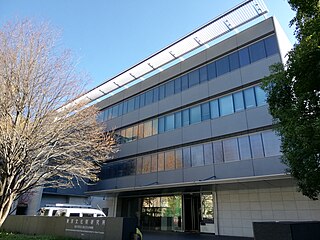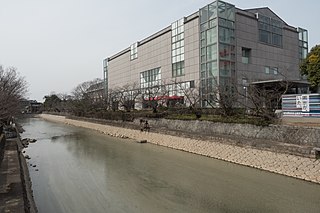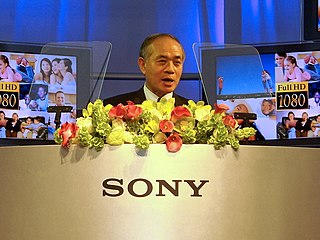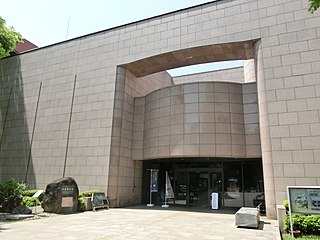Related Research Articles

The Tokyo National Museum or TNM is an art museum in Ueno Park in the Taitō ward of Tokyo, Japan. It is one of the four museums operated by the National Institutes for Cultural Heritage, is considered the oldest national museum in Japan, is the largest art museum in Japan. The museum collects, preserves, and displays a comprehensive collection of artwork and cultural objects from Asia, with a focus on ancient and medieval Japanese art and Asian art along the Silk Road. There is also a large collection of Greco-Buddhist art. As of April 2023, the museum held approximately 120,000 Cultural Properties, including 89 National Treasures, 319 Horyuji Treasures, and 649 Important Cultural Properties. As of the same date, the Japanese government had designated 902 works of art and crafts as National Treasures and 10,820 works of art and crafts as Important Cultural Properties, so the museum holds about 10% of the works of art and crafts designated as National Treasures and 6% of those designated as Important Cultural Properties. The museum also holds 2,651 cultural properties deposited by individuals and organisations, of which 54 are National Treasures and 262 are Important Cultural Properties. Of these, 3,000 cultural properties are on display at one time, with each changing for between four and eight weeks. The museum also conducts research and organizes educational events related to its collection.

The Kyushu National Museum opened on October 16, 2005, in Dazaifu near Fukuoka—the first new national museum in Japan in over 100 years, and the first to elevate the focus on history over art. The distinct modern impression created by the architectural facade is mirrored in the museum's use of technological innovations which are put to good in making the museum's collections accessible to the public. For example, the museum's extremely high resolution video system, with the latest image processing and color management software, serves both in documenting the objects in the museum's collection and also in expanding access beyond the limits of a large, but finite exhibition space.

The Nara National Museum is one of the pre-eminent national art museums in Japan.

The Kyoto National Museum is one of the major art museums in Japan. Located in Kyoto's Higashiyama ward, the museum focuses on pre-modern Japanese and Asian art.

The Agency for Cultural Affairs is a special body of the Japanese Ministry of Education, Culture, Sports, Science and Technology (MEXT). It was set up in 1968 to promote Japanese arts and culture.

The Tokyo National Research Institute for Cultural Properties, commonly known as Tobunken, is an institute dedicated to the preservation and utilization of cultural properties. It is one of the two institutes in Japan that comprise the National Institutes for Cultural Heritage, an independent administrative institution created in 2001.
An Incorporated Administrative Agency, or Independent Administrative Institution, is a type of legal corporation formulated by the Government of Japan under the Act on General Rules for Incorporated Administrative Agencies. The independent agencies are not under the National Government Organization Act that provides for the ministries and agencies of Japan.

The Nara National Research Institute for Cultural Properties, also known by its former name, the Nara Research Institute for Cultural Properties, is one of two research institutes that comprise the National Institutes for Cultural Heritage, an independent administrative institution created in 2001. Established in April 1952 as part of the National Commission for Protection of Cultural Properties,A the institute is located in the city of Nara, in Nara Prefecture, Japan, with branches elsewhere in Nara Prefecture. The institute is divided into departments for the excavation and restoration of the Asuka Palace, the Fujiwara Palace, and the Heijō Palace, historical remains, gardens, and other archaeological sites, and for the study of documents from Japan's early history. The Asuka Historical Museum is also managed by the institute.

The National Institute of Advanced Industrial Science and Technology, or AIST, is a Japanese research facility headquartered in Tokyo, and most of the workforce is located in Tsukuba Science City, Ibaraki, and in several cities throughout Japan. The institute is managed to integrate scientific and engineering knowledge to address socio-economic needs. It became a newly designed legal body of Independent Administrative Institution in 2001, remaining under the Ministry of Economy, Trade and Industry.
Japan was introduced to the idea of Western-style museums as early as the Bakumatsu period through Dutch studies.

The National Museum of Modern Art, Tokyo, also known as MOMAT, is the foremost museum collecting and exhibiting modern Japanese art. The museum, in Chiyoda, Tokyo, Japan, is known for its collection of 20th-century art and includes Western-style and Nihonga artists. It has a branch, the National Crafts Museum, in the city of Kanazawa.
Daigakkō is a word used in names of some post-secondary educational institutions in Japan. The National Defense Academy of Japan was established with École Polytechnique as its model. Most institutions in Japan that use "daigakkō" as part of their name are not certified as degree-issuing secondary schools by the Japanese Ministry of Education, Culture, Sports, Science and Technology or National Institution for Academic Degrees and University Evaluation (NIAD-UE), an independent organization.

The National Museum of Modern Art, Kyoto is an art museum in Kyoto, Japan.
Independent Administrative Institution (IAI) National Museum was the official name of the corporate entity created by the Japanese government in 2001 by merging three formerly independent national museums—the Tokyo National Museum, the Kyoto National Museum, and the Nara National Museum. The assimilated organizational structure was brought about as a part of the national government's administrative reform program; and the clear goal was to provide higher quality and better educational services to the public. In 2005, a fourth institution was added—the Kyushu National Museum. These reforms are designed to bring keiretsu-like synergy and enhanced administrative efficiencies in the work of achieving the range of inter-related preservation, conservation, and education goals of each unique institution.

Ryōji Chūbachi is a Japanese businessman, former vice chairman and president of Sony Corporation. He joined the company in 1977, later replacing Kunitake Andō to become president of the firm March 7, 2005. He was replaced as president by Howard Stringer on April 1, 2009. Chūbachi retired from Sony on March 31, 2013. Currently he is the president of the National Institute of Advanced Industrial Science and Technology (AIST), an independent administrative institution (agency) of the Ministry of Economy, Trade and Industry.

Yoshinori TokuraForMemRS is a Japanese physicist, Professor at University of Tokyo and Director of Center for Emergent Matter Science (CEMS) at RIKEN. He is a specialist in physics of strongly correlated electron systems and known for his work in high-temperature superconductivity, Mott transition, colossal magnetoresistance, Multiferroics, and magnetic skyrmions.
The Japanese government has established National Research and Development Agencies that fall under the Ministry of Education, Culture, Sports, Science and Technology (MEXT).
Naoko Tosa is a Japanese media artist based in Fukuoka, Japan. In recent years Tosa has been creating artwork expressing Japanese tradition and culture without utilizing digital technology but rather by taking photographic captures of water and flowers in motion at 2000 frames per second. Much of her focus is based on Japanese Zen, Shinto and Rinpa traditions. Rinpa, a school of painting which traces its origins to 17th century Kyoto emphasizes natural subjects, refinement and the use of gold leaf, and is a key influence in Tosa's most recent works.

The Museum Act is a Japanese law covering matters relating to the country's museums. The law was passed as Law No. 285 in 1951 and was last amended in 2008.

The Geological Survey of Japan (GSJ) is a research institute and department of the National Institute of Advanced Industrial Science and Technology (AIST), an Independent Administrative Institution under the Ministry of Economy, Trade and Industry (METI). The Survey was initially formed in 1882 under the Ministry of Agriculture and Commerce. The Geological Survey of Japan conducts surveys of and publishes research into the geology of Japan, produces geological maps of Japan, and operates the Geological Museum.
References
- Jain, Purnendra. (2005). Japan's Subnational Governments in International Affairs. London: Routledge. ISBN 978-0-415-33367-2
- Katada, Saori N., Hanns Maull and Takashi Inoguchi. (2004). Global Governance: Germany and Japan in the International System. Aldershot, Hants: Ashgate Publishing. ISBN 978-0-7546-4142-1 OCLC: 53831566